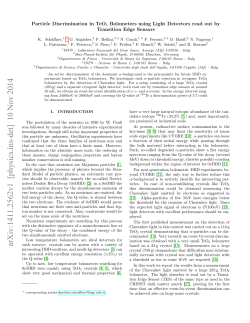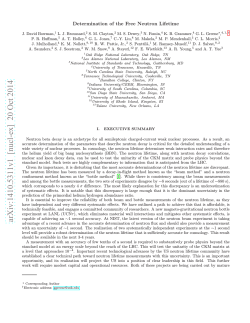
B DECAYS, AN INTRODUCTORY SURVEY.
LPTHE-Orsay 94/54// hep-ph/9403341 B DECAYS, AN INTRODUCTORY SURVEY. A. Le Yaouanc, L Oliver, O.Pene, J.-C. Raynal LPTHE, F 91405 Orsay, France,1 Presented by O. Pene. Abstract To start the b-decay session we briey introduce and comment some important theoretical tools which are currently used in b physics. Heavy Quark Symmetry and its consequences for heavy to heavy and heavy to light semi-leptonic decays, as well as for leptonic decays, are briey summarised. It is stressed that symmetry must be completed with dynamical calculations. A critical discussion of the nearest pole dominance (VMD) assumption is performed. Parton model and its higher twist corrections are discussed on the example of lifetimes. Finally non-leptonic decays are considered via the example of the exclusive calculation of in the Bs B s system. The popular factorization assumption is discussed and seems to be rather good. 1 What is so exciting about beauty? HEP-PH-9406341 This talk should be taken as a short introduction to the following ones on beauty decay. Beauty physics has become one of the most active elds. It would be dicult to quote one large experimental device able to produce b's which is not making of the study of b decays one of its priority. Several thousand physicists are actively engaged in this eld. What is the reason for this growing enthousiasm? Let us try some answers. Beauty is heavy, while charm is not so heavy and top will not produce hadrons. This implies several theoretical niceties: Heavy Quark Symmetries, validity of parton model, etc. It also implies that there are many nal states and hence a rich phenomenology. 1 Laboratoire associe au Centre National de la Recherche Scientique. 1 Beauty is rather stable. The coupling of the third generation to the other two turns out to be rather small, (O(2 )) in Wolfenstein's parameterization. This lucky feature raises serious hopes that CP violation may be measured in B decay. In fact, a long standing intimacy has existed between beauty and CP violation, since the third generation was postulated by Kobayashi and Maskawa because their mechanism for CP violation needed it. But CP violation is out of the scope of this talk and we shall leave it aside, after having reminded you that it is presumably the main reason of the widely spread enthousiam for B physics. The worst known CKM parameters concern the third generation: Vub , sin , .. We need these parameters, for the sake of SM itself, and hopefully to learn something unexpected beyond it. 2 Main Theoretical tools for b decays. We will restrict ourselves to heavy-light hadrons: Qq mesons and Qqq0 baryons where Q represents any heavy quark and q; q0 any light quark. Let us make a list of the main concepts, principles, rigourous methods, models, etc. that are commonly used: Heavy Quark Symmetry Duality and Parton Model Lattice QCD QCD Sum Rules Quark Models Analiticity, Vector Meson Dominance,... Factorization assumption for non-leptonic decays. We will try to say a few words on these items, except for lattice calculations that will be considered later by Asmaa Abada [1] and QCD sum rules on which Stephan Narison will give a review. For lack of time we will also skip quark models although they are able to give a precious physical insight. Recent analyses of the latter may be found in [3]. 3 Heavy Quark Symmetry (HQS) It is strange that the HQS has only been understood recently, although it is a direct consequence of QCD. It was anticipated by some works in the late eighties and fully emphasized only four years ago. It is impossible to quote but a few among the huge number of publications it has triggered in such a short period: [5]-[7]. Although you must all have heard of HQS, it is unavoidable to say some words about it. The basic idea may be explained through the \atomic picture": Up to small corrections, the properties of an atom depend only on the electric charge of the 2 nucleus (the atomic number), not of its atomic mass. This is because the nucleus is so heavy vz the electron that it is practically at rest in the center of mass of the atom, and it acts as a static electric charge. Mutatis mutandis, this happens when a heavy quark is bound with a light quark. Up to O(1=mQ ) corrections, the heavy quark acts as a triplet static source of color. In other words, let us write the heavy quark momentum as p = mQv + k where mQ is the heavy quark mass, v is the hadron four velocity (momentum divided by the mass), and k is a momentum that represents the eect of the wave function, and it is of the order of the QCD scale, remaining constant when mQ ! 1. imQ=v + k= i=v + 1 ' (1) 2 2 (mQv + k) mQ 2v k where the ' symbol here means up to O(1=mQ ) corrections. Flavor symmetry is obvious since no dependence on the heavy mass is left. Let us now assume many soft gluons emitted from the heavy line: u(s; v) i=v2+1 ita i=v2+1 itb i=v2+1 ::: = u(s; v) i=v2+1 tatb:::vv ::: No dependence on the heavy quark spin is left, and we end up with a SU (2NF )v symmetry where NF is number of heavy avors. One should notice however that the symmetry acts inside a sector corresponding to one heavy hadron velocity. This is the meaning of the index v. 4 Scaling laws and symmetry relations in the heavy quark limit. We turn to the phenomenological consequences of HQS on leptonic decays, heavy to heavy semi-leptonic decays and nally heavy to light semi-leptonic decays. Although the second one is the best known, the other two are also very useful for phenomenology. In all this section we will neglect anomalous dimensions. 4.1 Scaling laws for letponic decay constants: B; D ! l Let us simply state the result [5]. The leptonic decay constant of a heavy pseudoscalar meson P composed of a heavy quark Q and a light one q scales like FP MP1=2 m !!1 contant + O( 1 ) (2) MP Q and, of course MP ' mQ. The same is true for a vector meson with the same constant. But the symmetry does not tell us: How much is the constant? How large are the 1=MP corrections? what is their sign? For the answer we need to ask Lattice QCD and QCD sum rules [1],[2]. These p two methods yield the same result: the 1=mQ are such as to soften the 1= MP 3 FP as a function of MP . In practice, the predictions for FB are not very dierent from those for FD while scaling rules without corrections would predict FB =FD ' 0:6. decrease of 4.2 Scaling laws for Semi-leptonic decay B ! Dl < D(v0)jV jB (v) > < D(v0)jV jB (v) > < D(v0)jAjB (v) > ! mQ !1 ! mQ !1 ! mQ !1 pM M (v v0)(v + v0) B D p MB MD (v v0) v0v pM M (v v0)(v v0 + 1 vv0 ) B D (3) where (v:v0) is the celebrated Isgur-Wise function [7], with (1) = 1 (corresponding to v0 = v). But: (y) is unknown for y 6= 1 How large are the )(1=mQ) corrections? This scaling law has already proven to be very useful for phenomenology. Neubert [8] has proposed a direct use of the relations (3) and of the normalization (1) = 1 to measure jVcb j from B ! Dl . Using this method CLEO [9] obtains jVcb j = 0:037 0:005 0:004. 4.3 Scaling laws for Semi-leptonic decay B ! K (); ; l In the rest frame of the initial (heavy) meson [6]: < K (p); ~p jJjB > ' < K (p ); ~p jJjD > MB MD if j~pj; MK ; MK MD ; MB 2 . Once again, Notice that small j~pj means q2 qmax the symmetry provides a relation between matrix elements, but not their values neither the size and sign of the corrections. Lattice QCD [1] gives a preliminary answer: for A1 and V the corrections tends to soften the MP dependence of the dominant term (similarly to the case of FP ), A2 presents the opposite trend but with large errors, and f+ is close to the uncorrected scaling. A phenomenological analysis [3] of B ! K tends to conrm the general trend of a \soft" scaling which can be understood very simply in the quark models [3], [4]. 5 dependence of form factors : Beware of Vector Meson Dominance ! q2 Little is known about the q2 dependence of the form factors (q2 is the invariant squared mass of the nal leptons). The scaling laws described in section 4.2 predict only the q2 dependence of the ratio between dierent heavy to heavy 4 form factors. But this limited piece of information is missing in the case of heavy to light form factors. There is a wide-spread belief that the nearest pole dominance should not be a bad approximation, i.e. F (q2) / q2 1M 2 (4) B0 where we call B 0 the lightest state which has the quantum numbers exchanged in the t channel, for example B ; B , .... If we consider, say, B ! l , the physical 2 = (M 2 2 region corresponds to 0 q2 qmax B M ) < MB 0 . Pole dominance is 2 when the pole valid only in the vicinity of the pole. It may be valid near qmax is not too far away, but it is certainly not valid in the whole range. Many other poles, cuts, etc contribute. If lattice estimates [1] seem to favor form factors that 2 , QCD sum rules seem to indicate no pole dominance increase with q2 near qmax for axial form factors[10], and a phenomenological analysis of B ! K [3] also seems to discard pole dominance in favor of a dierentiated behaviour for the various form factors. A weak binding relativistic quark model predicts A1 to be atter than f+ [3], [4]. 6 Duality and parton model, life times. 6.1 Plain parton model. Parton model assumes that the total width (B ! everything) ' (b ! cqq; cl). It is based on the idea that the spectator quark plays no role because the nal quarks are hard. Plain parton model then predicts B0 = B = b 0 + as it would predict D = D = c if charm was assumed to be heavy. The latter assumption is in total contradiction with present experimental values: 13 D0 = 4:20 0:08 10 13 s; D+ = 10:66 0:23 10 13 s; c = 1:91 +00::15 12 10 s and c = 3:20 +00::98 10 13 s [11]. We see that charm cannot be considered as heavy under this respect. What about beauty? The present situation [12] is: B = 1:14 0:15; Bs = 1:11 0:18; b = 0:75 0:12: (5) B0 B0 B0 This looks much better than for the charm, but b =B0 is two sigmas away from the uncorrected parton model prediction. 6.2 How to compute the corrections to parton model? A recent series of papers [13] propose a generalization of parton model: (HQ ! X ) / G3F < HQjImT^(Q ! X ! Q)jHQ > (6) is expanded into matrix elements of the operators vQ Q, Q(D2 (v D)2 )Q, Q G Q, Q qq Q, etc. 5 The rst operator, Q=vQ, of dimension three, gives the parton model. Next, there are no 1=mQ corrections. The O(1=m2Q ) corrections are generated by the dimension ve operators. The Q(D2 (v D)2 )Q corresponds to the Fermi motion. The Q G Q matrix ele- ment is known from hyperne splitting between meson masses. These dimension ve operators do not split the meson life-time degeneracy. To O(1=m2Q ) 2 c: b 6= B0 = B+ ) b B00 ' m (7) 2 m c D b It is gratifying that experiment seems to conrm that jb B0 j > jB+ B0 j. However it is still unclear if this model can account for such a small b =B0 ratio as 0.75. The most interesting O(1=m3Q ) operator is Q qq Q since it produces the rst non-spectator eect (the light quark elds can act on the spectator quarks). It results: B+ B0 ' m3c (8) + 0 m3 D D b Finally, this approach is new and still under discussion, however it has several nice features and certainly deserves further work. 7 Non-leptonic decays and factorization assumption 7.1 Some general remarks. Non leptonic decays represent the dominant decay channels of the B 's. But there exists no exact method to deal with them. One usually resorts to the factorization assumption which allows to express two body non leptonic decays as a product of a semi-leptonic amplitude and a purely leptonic one. It neglects the softgluon exchange between the two parts of the diagram. It is only valid when Nc ! 1, but in B physics it often appears to be a reasonable approximation with phenomenological coecients, a1; a2, multiplying both relevant four quark operators. CLEO [14] has carefully checked factorization for Nc dominant decays, and the success of factorization seems to extend to their t of the a2=a1 ratio which is O(1=Nc ). There is an overwhelming number of studies of non-leptonic decays. We will give a recent example [15] noticeable, in the realm of non-leptonic decays, by the fact that a calculation of phenomenological interst turns out to be unexpectedly under control. 7.2 An example: exclusive computation of in Bs Bs The Bs Bs system has M= 1, which makes it dicult to measure [16] the too fast oscillations sin(M t). What about ? Is = large enough 6 to allow it to be seen and used?2 Inclusive parton model calculations [17] give: = ' 0:20. The question is, what are the eects of the lightest exclusive channels? Should they be added to parton model contribution? Are they dual to it? The analysis [15] leads to the following conclusions: The dominant decay channels are Ds Ds; Ds Ds; Ds Ds ; DsDs . These channel contribute mainly with the same sign to . Their con- tribution is known in a model independent way from experimental [18] Bd ! Ds()D() branching ratios. Factorization is a reasonable assumption in this case. Exclusive and inclusive calculations are dual: they are not to be added, they should approximately agree, and they do ! = ' 0:15 This is maybe the largest lifetime dierence among the B 's, and it is measurable [19] ! 8 Conclusions Heavy Quark Symetry is a simple and powerful consequence of QCD. But it needs to be completed by dynamical computations of universal constants, universal functions, and 1=mQ corrections. There are several instances where the 1=mQ corrections tend to soften the dependence on the heavy mass indicated by the dominant term. The corrections to parton model for inclusive processes may be understood via a systematic expansion in higher dimension operators. Lattice QCD predicts leptonic decays and semi-leptonic ones (for not too large momenta). The q2 dependence of the form factors is still largely unknown. Nearest pole dominance has no theoretical grounding and there are indications of other behaviours. QCD sum rules may help in this problem. Non-leptonic decays are tractable, using the factorization assumption which seems not too bad. Improvement needs an understanding of the corrections to it, and of duality. Acknowledgments : I would like to thank the organisers of the rencontres, with a particular thought for Joelle Raguideau who was wounded the last day. This work was supported in part by the CEC Science Project SC1-CT91-0729. 2 Remember how useful has been, in the K K system, the fact that (KS ) (KL) and hence the fact that only KL 's y a few meters before decaying. 7 References [1] As. Abada, these proceedings. [2] S. Narison, these proceedings. [3] R. Aleksan, A. Le Yaouanc, L. Oliver, O. Pene, J.-C. Raynal, LPTHEOrsay 94-15 (1994). [4] A. Le Yaouanc et al., Gif lectures 1991 (electroweak properties of heavy quarks), tome 1, p89; A. Le Yaouanc and O. Pene, Third workshop on the Tau-Charm Factory, 1-6 june 1993, Marbella, Spain, Bulletin Board: hep-ph 9309230; R. Aleksan et al., Beauty 94 workshop, april 1994, Mont Saint Michel, France (to be published in Nucl. Inst. and meth. A) Bulletin Board: hep-ph 9406334. [5] M.B.Voloshin and M.A.Shifman, Sov.J.Nucl.Phys. 45 (1987) 292; Sov.J.Nucl.Phys. 47 (1988) 511 H.D.Politzer and M.Wise, Phys.Lett. B206 (1988) 681; Phys.Lett. B208 (1988) 504; E.Eichten, Nucl.Phys. B(Proc.Suppl.)4 (1988) 170; [6] N. Isgur and M.B. Wise, Phys.Rev. D42 (1990) 2388. [7] H.Georgi, HUTP-91-A014; J.D.Bjorken, SLAC-PUB-5362, SLAC-PUB-5389; N.Isgur and M.Wise, Phys.Lett. B232 (1990) 113, Phys.Lett.B237 (1990) 527, Phys.Rev.Lett. 66 (1991) 1130; H.Georgi and F.Uchiyama, Phys.Lett.B238 (1990) 395; H.Georgi and M.Wise, Phys.Lett. B243 (1990) 279. [8] M. Neubert Phys.Lett.B264 (1991) 455. [9] C. O'Grady, these proceedings. [10] P. Ball, TUM-T31-39-93, Bulletin Bd.: hep-ph@xxx.lanl.gov - 9305267. [11] A. Simon, these proceedings. [12] T. hessing, proceedings of the XIX Rencontre de Moriond '94 Electroweak Interactions and Unied Theories, Editions Frontieres. [13] cf. for instance I.I. Bigi CERN-TH-7050/93, Invited talk at Advanced Study Conference on Heavy Flavors, Pavia, Italy, 3-7,Sep 1993, and references therein on the work of M. Shifman, M. Voloshin, B. Blok, N. Uraltsev, A. Vainshtein and I. Bigi. [14] S. henderson, these proceedings. [15] R. Aleksan, A. Le Yaouanc, L. Oliver, O. Pene, J.-C. Raynal, Phys.Lett.B316 (1993) 567, B317 (1993) 173. [16] S. Tarem, these proceedings. 8 [17] S. Hagelin Nucl. Phys. B193 (1981) 123. [18] Particle Data Group, Phys. Rev D45 (1992) Part II. [19] Y. Cen, these proceedings. 9
© Copyright 2025





















